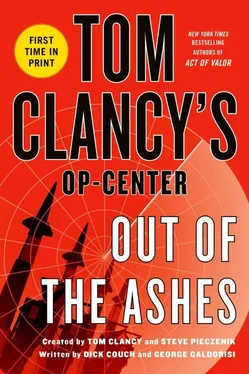* * *
Brian Dawson entered Chase Williams’s office with Roger McCord and Aaron Bleich in tow. The N3 was usually an island of calm, but as soon as he walked in, Chase Williams could see the urgency in his body language.
“Morning, boss,” Dawson began. “Thanks for seeing us on such short notice.”
“No problem, Brian. I’m assuming this has something to do with the shootout in the Gulf.”
“It does,” he replied. “Roger and Aaron and my folks have talked this over and we’re anticipating a reaction — probably a strong one — from the Iranians after this dustup. We’ve already asked General Albin’s people to loop us in with all the SIGINT they get from Iran,” Dawson continued, referring to signals intelligence Central Command would collect from multiple sources monitoring Iran.
“I agree. That sounds like the prudent thing to do.”
“That’s not all, boss. We’re also watching our forces in and around the Gulf. General Albin’s still got a lot of combat power concentrated there and while no one has said anything officially, we think the U.S. might retaliate for this mining of the Strait of Hormuz. We don’t know if or when or how yet, but if that happens, then the next move the Iranians make could be something that ups the ante even more.”
“Roger, I assume you and Aaron and his team are sharpening their focus on what the Iranians might do to retaliate.”
“We are,” McCord replied. “Intel community is in overdrive on this and we’re mining all their feeds, and Aaron and the crew are already working their anticipatory intelligence algorithms. We’re not certain precisely what we’re looking for, but I’m pretty confident we’re doing everything we can.”
“Good,” Williams replied. “Aaron, you and your team need anything, just let us know.”
“Got that, sir. We’re good for now, but if we do I’m sure Ms. Sullivan has an open checkbook,” Bleich replied with a wry smile.
“Good luck with that,” Williams replied, “but I’ll be sure to let her know.” His team was working on all cylinders and his gut told him they might need to pull a rabbit out of the hat.
* * *
Laurie Phillips and Sandee Barron had been flown to Truman, where they were treated for their injuries. Both were then brought back to Washington for debriefings and follow-on medical attention. As a serving naval officer, Sandee was still bound by the constraints of her service. Laurie, a government contractor, had similar though less binding restrictions. Their experience and collective information was of interest to a number of agencies as well as the United States Navy. Individually and together, they endured a series of debriefings. Some were amiable and sought information about the events in Saudi Arabia. Others were along the lines of an inquisition as to why they were where they were, and what regulations and conventions they had broken in making the journey.
The White House Oval Office, Washington, D.C.
(April 8, 1000 Eastern Daylight Time)
President Wyatt Midkiff sat in the Oval Office considering what had happened over the past month. He had reason to be satisfied, but he also had reason to be concerned, gravely concerned.
Yet another war in the Mideast had been averted, but only by the narrowest of margins. He was happy Chase Williams and his Op-Center team had been there to assist during a time of crisis. More than that, they had been able to respond rapidly and execute their mission without mishap — a mission that changed in midstream. The president was still receiving congratulations from the heads of state of allies and partners for not only averting war in the Mideast, but for opening the Strait of Hormuz so quickly. The price of oil was back down to precrisis levels and financial markets had begun to stabilize.
Over the past week he had attended a seemingly endless series of meetings with his National Security Staff. Now Trevor Harward entered his office for yet another of their scheduled meetings, this one between just the two of them.
“Mr. President.”
“Trevor,” Midkiff said to his national security advisor as they moved to the conversational area in front of the president’s desk, “we know why we’re here so let’s get to it. Please have a seat.”
“Thank you, Mr. President.” Midkiff waited expectantly, so Harward plunged ahead. “Sir, we’ve had our meetings, and General Albin has had a chance to position his forces where he feels he needs them. The 5th Fleet commander has the Truman and Vinson carrier strike groups both ready and steaming in the Gulf of Oman. We’ve stepped up our monitoring of the Iranian networks, and we are confident they are not at a heightened state of alert.”
“So you are saying we’re ready to move forward.”
“Yes, Mr. President.”
Midkiff had conferred with two former presidents, one from each of the two parties, and asked them for their counsel. He had also spent time with several individuals who were both career politicians and personal friends. Yet he was as conflicted as he had ever been in his life, and he still couldn’t decide. After a long moment, he turned to his national security advisor.
“Trevor, I still need some time.”
“Mr. President?”
“I said I need more time.”
Harward paused for a few seconds, then rose. “Yes, Mr. President.” He left the Oval Office without another word.
* * *
Rear Admiral Jack “Stinger” Smith, the commander of Naval Air Forces Atlantic, sat quietly in his office. He, too, was conflicted. He had a decision to make, and it was one that troubled him. He had read the report multiple times, and had consulted with his senior staff, but the decision was his and his alone to make. There was a sharp knock on his door. “Enter,” he barked as he rose to stand behind the podium that had been placed next to his desk. Lieutenant Sandee Barron and her commanding officer, Commander Rick Kennedy, walked quietly in. Both were attired in their Service Dress Blue uniforms.
“Commander Kennedy and Lieutenant Barron reporting as ordered, Admiral,” Kennedy said.
Admiral Smith, who loved his pilots only slightly less than he did his twin granddaughters, did not put them at their ease. Both Kennedy and Barron read this as not a good sign.
“Lieutenant Barron, please step forward.” She did. Then, without preamble, the admiral began reading from the script his legal officer had prepared.
“Lieutenant Barron, you are standing before me, the commander of Naval Air Forces Atlantic. I am the first flag officer in your chain of command. Do you understand why you are here?”
“Yes, Admiral.”
“Do you understand that these are not legal proceedings and that a potential court-martial case is being brought against you for numerous violations of the Uniform Code of Military Justice?” He looked up at her for confirmation.
“Yes, Admiral.”
“You are appearing here for one reason only, and that is for me to determine if you are to retain the privilege of wearing your naval aviator’s wings.”
“I understand, Admiral.”
“Commander Kennedy, what can you tell me about this lieutenant?”
Commander Rick Kennedy had anticipated the question and was ready. Kennedy spoke for ten minutes, often passionately, about Sandee Barron’s fine qualities as a naval aviator. He, without qualification, said that she was the best pilot in the squadron and that she had a bright future in naval aviation. He ended by describing in some detail her remarkable feat of airmanship in getting Swampfox 248 on the deck after the RPG had taken out its tail rotor, describing for the admiral, who was not a helicopter pilot, the extreme difficulty of maintaining control of a helicopter in that situation. Finally, he was done.
Читать дальше












